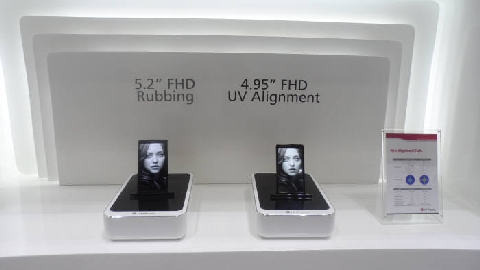<4.95” display applied with both UV alignment and N-type liquid crystal technologies (right). The contrast appears to be distinctly superior to the existing products even to the naked eye.>
According to the industry on the 12th, LG Display will start mass-producing AH-IPS (Advanced High Performance In-plane Switching) LCD, which has been applied with both UV alignment and N-type liquid crystal technologies to lower power consumption by 12% and to improve contrast ratio and brightness by 30% and 20% respectively, in the third quarter.
UV alignment and N-type liquid crystal technologies are aimed at improving LCD performance and lowering power consumption by increasing light transmittance. In substrate and top plate fields, oxide and these two technologies are known as alternatives to lower power consumption respectively. As low power has become a hot issue in the mobile market, display makers embarked on the related technology development. However, these companies experienced difficulties in commercialization because of their weaknesses in process and materials technologies. LG Display, through cooperation with materials makers, successfully developed AH-IPS LCD to realize both UV alignment and N-type liquid crystal technologies.
Both UV alignment and N-type liquid crystal increase light transmittance. In a finished LCD product, only around 4 ? 5% of light coming from light-emitting diode (LED) reaches human eyes. An excellent power consumption effect is achieved just by reducing factors blocking light little by little in each process and part comprising an LCD.
UV alignment is a technology to create a path for liquid placement using photo-induced polymerization monomer. Until now, IPS liquid crystal has been applied using a method to rub petroleum on the surface of a polymer film to cut a groove in a consistent direction, and thus to have liquid crystal aligned along the groove. The rubbing method is associated with such problems as static electricity or scratches formed on the film surface. Therefore, UV alignment that does not involve any physical friction drew attention. UV alignment minimizes light leakage, and thus produces high contrast ratio. In addition, the pre-tilt angle of liquid crystal is close to 0. Therefore, consistent display quality is achieved regardless of the viewing directions.
N type liquid crystal produces higher transmittance than the existing P-type (positive) liquid crystal, and thus can drastically improve display brightness. N-type liquid crystal refers to a liquid crystal of which the difference in permittivity between major and minor axes is negative (-). When applied with voltage, N-type crystal display moves centering on the minor axis. Therefore, the area of light transmission becomes wider. It has been difficult to use N-type liquid crystal in IPS mode where liquid crystal moves horizontally when applied with voltage. “The industry calls ‘oxide thin film transistor (TFT), UV alignment and negative (N-type) liquid crystal’ the ‘three conundrums of mobile and low-power technology’,” said an LG Display insider. “We have secured all of the three technologies.”
Mun Bo-gyeong | okmun@etnews.com
LG디스플레이, UV배향?N액정 동시 구현한 스마트폰용 디스플레이 개발
12일 업계에 따르면 LG디스플레이는 오는 3분기부터 두 기술을 동시 적용해 소비전력을 12% 떨어뜨리고 명암비는 30%, 밝기는 20%나 끌어올린 AH-IPS(Advanced High Performance-In Plane Switching) LCD 양산을 시작한다.
UV 배향과 N형 액정은 모두 빛의 투과율을 끌어올려 LCD 성능을 향상시키고 소비 전력은 줄이는 기술이다. 기판에서는 옥사이드 TFT, 상판에서는 이 두 기술이 소비 전력을 줄일 수 있는 대안으로 꼽힌다. 모바일 시장에서 저전력이 화두가 되면서 디스플레이 업체들이 기술 개발에 나섰으나, 그동안 공정과 소재 기술이 취약해 상용화에 애를 먹었다. LG디스플레이는 소재 기업들과 협력해 UV 배향과 N형 액정 모두를 구현한 AH-IPS LCD를 개발하는 데 성공했다.
UV 배향과 N형 액정은 빛 투과도를 높이는 기술이다. 발광다이오드(LED)에서 나온 빛은 LCD 완제품이 됐을 때 고작 4~5% 정도만이 사람 눈에 도달한다. LCD 각 공정과 부품에서 빛을 가로막고 있는 요소를 조금씩만 줄여줘도 소비전력 절감 효과는 뛰어나게 된다.
UV 배향은 광중합성 모노머를 사용해 액정이 놓이는 길을 만들어주는 기술이다. 지금까지 IPS 액정은 고분자 필름 표면에 섬유를 문질러(러빙) 일정한 방향으로 홈을 파 액정을 배향시키는 방식이 적용됐다. 러빙 방식은 정전기나 스크래치 문제가 있어 물리적 마찰이 없는 UV 배향 기술이 주목을 받았다. UV 배향은 빛이 새는 것을 최소화해 높은 명암비를 얻을 수 있으며, 액정의 선경사각(pretilt angle)이 0에 가까워 보는 방향과 관계없이 균일하게 볼 수 있는 특징이 있다.
N형 액정은 기존 P형(positive) 액정보다 투과율이 높아 휘도를 획기적으로 개선할 수 있다. N형 액정은 장축과 단축의 유전율 차이가 음(-)인 것을 말한다. N형은 전압이 걸렸을 때 단축을 중심으로 움직이기 때문에 빛을 투과시키는 영역이 넓어진다. 전압이 걸리면 가로로 움직이는 IPS 모드에서는 그동안 N형 액정을 적용하기 힘들었다. LG디스플레이 관계자는 “‘산화물(옥사이드) 박막트랜지스터(TFT), UV 배향, 네거티브(N형) 액정’ 이 세 가지를 업계에서는 모바일 저전력의 3대 기술 난제라고 부른다”며 “이 기술들을 모두 확보했다”고 말했다.
문보경기자 | okmun@etnews.com
